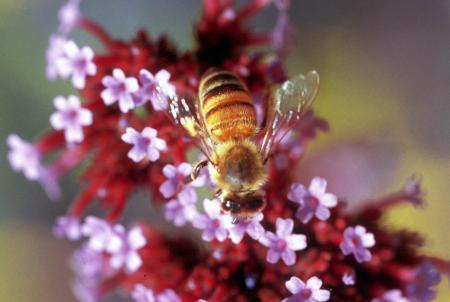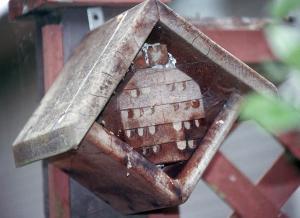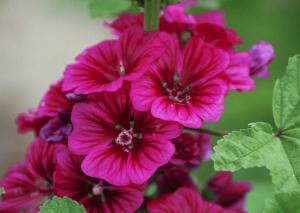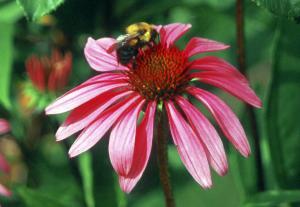A lesson for gardeners
By Theresa M. Forte
 | |
| Bees enjoying the dainty blossoms of Verbena bonariensis. |
A more sensitive gardener might have been offended. However, I was impressed by their astute observation, a healthy garden is virtually alive with bugs. Fortunately, most of these are not harmful to our precious plants and can be considered to be beneficial, performing a variety of services for gardeners.
What's your favourite bug? (Yes, I did say favourite bug!) One of my favourites is the ladybug. They are cute (red/orange back with black spots), friendly, and have voracious appetites for aphids. According to Ecological Gardening by Marjorie Harris, "The larvae of this most useful of all bugs can down 25 aphids a day, the adult 56 a day. And one coupling will produce from 200 to 1,000 offspring. They can get into areas no spray could possibly penetrate." No matter what the exact numbers are, the important fact is that ladybugs can be a great help to the gardener. Look to marigold, butterfly weed (Asclepias tuberosa) and yarrow (Achillea), among others, to attract ladybugs to your garden.
Bees are another helpful visitor. They are essential to pollinate the flowers in a garden. Without pollination the plants cannot bear fruit. In early summer, lamb's ears (Stachys byzantina), sedum and thyme groundcovers are virtually humming with bees. Left to their own devices, the bees are consumed with their nectar collecting. They don't seem to notice me quietly working in the garden nearby.
|
Bumblebees are warm blooded, allowing them to fly in cool conditions. They are among the first visitors to the garden in the early spring, and will be encouraged with plantings of early blooming per-ennials. Favourites include the Lenten rose (Helleborus x hybridus), lungwort (Pulmonaria) and Lamium maculatum. Hardy bulbs produce flowers attractive to bees, allium, crocus, scilla and grape hyacinth (Muscari) are all favourites. During a garden photo shoot in early April, I was bundled up to keep myself warm. To my surprise the garden was animated by the sound of bees buzzing all around me, visiting the colonies of hellebores I was photographing. Bumblebees prefer tubular-shaped flowers. Foxglove (Digitalis) are pollinated as the bees diligently work the nectar-rich tubes, starting at the bottom and working their way up the flower spikes (there's more nectar on bottom and more pollen on top). Among their preferred summer plants are drought-tolerant, easy-care plants such as sage, thyme, lavender, marjoram, Buddleia and catmint (Nepeta). Honeybees visit gardens during the summer months. They are cold blooded, and hence need warm weather to fly. Because of their work habits, honeybees are wonderful pollinators for fruit trees, they continue to visit a tree until its nectar is exhausted. Honeybees also have distinct preferences when it comes to flower shapes, preferring round, saucer-shaped flowers, ideally with single petals such as Rosa rugosa 'Hansa'. Other favourites include hollyhock, primrose (Primula), mallow (Malva), bachelor's button (Centaurea cyanus), salvia and verbena. Foraging bees identify desirable flowers by colour, shape and smell. Generally invisible to the human eye, the nectar serves as a neon billboard for bees. Yellow, the colour of pollen, is another bee favourite. Regardless of colour, if a blossom doesn't provide enough pollen or nectar, bees will ignore it. Other beneficial insects include wasps (several varieties), ground beetles and lacewings. According to Harris, these eat a variety of pests such as gypsy moth, mealybugs, aphids, spider mites, leafhoppers and caterpillars, to name a few. Ground beetles are particularly fond of slugs and cutworms, there is no accounting for taste! Songbirds are a charming way to keep undesirable insects under control while adding their lively songs and colours to the garden. In order to attract birds, plant a border of fruit-bearing shrubs around the perimeter of a property, or include them in border designs. Shrubs such as serviceberry (Amelanchier canadensis), dogwood (Cornus), Viburnum and Rosa rugosa all bear fruit attractive to birds. Birds also look for a sheltered spot to nest. Evergreen shrubs such as cedar, spruce and juniper provide year-round shelter, as well as beautiful bones for the garden. Birds will help keep grubs, beetles and flying insects to a minimum. A birdbath will attract birds to the garden, as well as provide clients with plenty of entertainment, if it can be viewed from the house or patio. Bees also need a reliable supply of water throughout the growing season. They use water to cool their hives and dilute the honey they feed to their larvae. Remember that any pesticides used in the garden will affect the balance of wildlife. Invite beneficial insects and birds into the garden and they will help to keep the 'undesirables' in check, while adding to the vitality of your garden. Although my garden does attract its share of bugs, I don't mind in the least. They keep themselves quite busy and do not seem to notice me as I work in the garden. My husband often jokes that this is because they know who is providing their next meal. I don't know how much they understand, but it certainly is a nice thought. Theresa M. Forte is a garden consultant, writer and photographer based in the Niagara Peninsula. |


